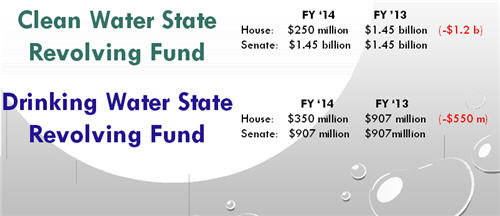The State Of Water And Wastewater: First, The Bad News…

By Kevin Westerling,
@KevinOnWater
A leading mind in the water/wastewater sector shares his view of the industry.
When G. Tracy Mehan talks, people listen.
That sort of respect comes from being the former assistant administrator for water at the U.S. EPA. Now a principal with The Cadmus Group, Mehan recently spoke at a meeting of the Water and Wastewater Equipment Manufacturers Association (WWEMA), where he painted a not-so-pretty picture of the state of America’s water and wastewater infrastructure. Bad news took precedence over good news, unfortunately, and was decidedly more prominent.
It was also evident from the start that Mehan would pull no punches in assigning blame. “The threats to our water systems come from our own fecklessness as a society,” he opened.
Mehan went on to explain how we got here and where we’re headed, sharing a breakdown of our current challenges (“The Bad News”) followed by a dash of optimism (“The Good News”).
The Bad News
Citing some recent reports that have become familiar to those in the water/wastewater space, Mehan noted that the estimated cost for drinking water infrastructure replacement is estimated at $1 trillion over the next 25 years, with wastewater infrastructure estimates less specific, but equally necessary. With so many other obligations, the problem is acquiring federal funding for these fixes.
“The operative assumption is that the federal government will actually fund a major water and wastewater infrastructure program after it gets around to highways, bridges, inland waterways, ports, entitlement reform, the Affordable Care Act, and paying off wars in Iraq and Afghanistan," Mehan stated.
“Unfunded liabilities over the years will drive the debt burden beyond anything we can imagine, especially as interest on the debt rises once the Federal Reserve takes away the punch bowl, as it inevitably must,” he said.
As a trickle-down effect of federal outlays, Mehan expects the State Revolving Funds (SRF) program — an integral part of water and wastewater infrastructure financing — to become “an ever-shrinking slice of the federal budgetary pie.” Indeed, SRF funding has already been slashed for 2014.

To make matters worse, politicians aren’t particularly interested in championing the cause of infrastructure spending. Mehan explained that "Most of our water and wastewater utilities are run by local governments and municipalities, subject to political leaders who must face election every four years. For them, raising water rates is equivalent to raising taxes and, therefore, a root canal. Often, they look to water systems as a source of revenue from which they can draw down funds to support, say, public pension funds or health insurance."
Again, unfunded liabilities trump water/wastewater infrastructure needs, which in reality are public needs. The solution, then, is to convince politicians and decision-makers that the investment is worth it (according to the UN, it is). On this point — the understanding and communication of the value of water — Mehan presented a silver lining.
The Good News
Besides federal money, infrastructure renewal must be funded by ratepayers, who generally pay far less for water/wastewater services than they do for less-necessary services such as cable TV or cell phones. As the public comes to understand and embrace the importance of water (i.e. stop taking it for granted), they are willing to pay more for it, thus easing the minds of fearful, self-preserving public officials in charge of rate-making.
“Water and wastewater utilities, as well as their political and community leaders, need to develop skills in strategic communication, marketing, branding, civic education, and outreach. They need to emulate a competitive business enterprise, not a traditional government monopoly,” stated Mehan.
Luckily, there are signs that the message is getting through.
Mehan noted that, nationwide, rates have been going up in the last few years, and held up Proposition 6 in Texas as an example of community-supported infrastructure funding. Texas voters overwhelmingly passed a constitutional amendment to finance state water projects, taking $2 billion in state money from a “rainy day fund” to provide loans for water infrastructure. “The vote in Texas reminds us that states can and do play a role in financing infrastructure projects, including the capitalization of their SRFs,” said Mehan.
As an industry, he stressed that “We need to emphasize not just the importance of full-cost pricing, but the tremendous value — the benefits and services — that water and wastewater utilities provide their customers and ratepayers. This is an important dimension that needs to be reinforced every day, in every message, and every interaction that utility managers and personnel have with the public. The story needs to be told… the blissful ignorance must come to an end."
Instead of merely stating that rates should be higher, Mehan commented that, structurally, utilities should move away from the overly constrained commodity model of pricing to a new, more accurate (and more compelling) services model of pricing. “Given declining rates of water consumption and the difficulty of loading fixed costs, which can be 80 percent or more, into a variable or volumetric water rate, the service model is clearly preferable,” he said.
As far as other drivers that can propel the water/wastewater industry to greater investment, Mehan recognized the important role of regulations. Nutrients and stormwater, in particular, are coming under increasing scrutiny, with pending regulations destined to dictate an increase in investment.
But perhaps the greatest driver — one that even the bleakest economic outlook cannot derail — is pure need: water and wastewater services are imperative to our way of life.
“In the long-run, America must invest in its infrastructure,” said Mehan. “There really is no choice, is there?”
For further industry analysis from G. Tracy Mehan, listen to his exclusive interview with Water Online Radio.
